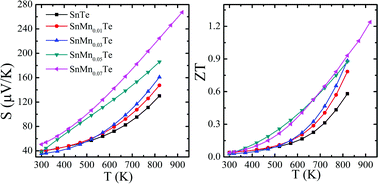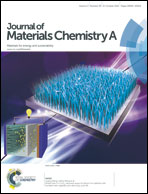Valence band engineering and thermoelectric performance optimization in SnTe by Mn-alloying via a zone-melting method†
Abstract
Tin telluride (SnTe) has recently attracted lots of interest due to its potential thermoelectric application as a lead-free rock-salt analogue of PbTe. However, pristine SnTe samples have high hole concentration due to the presence of intrinsic Sn vacancies, and shows a low Seebeck coefficient and high electrical thermal conductivity, resulting in poor thermoelectric performance. In this report, we show that zone-melted SnTe systems with additional Mn (1–7 mol%) can control the hole concentration by reducing the Sn vacancies, and modulate the electronic band structure by increasing the band gap and decreasing the energy separation between the light and heavy hole valence bands. Therefore, alloying with additional Mn enhances the contribution of the heavy hole valence band and significantly improves the Seebeck coefficient in SnMnxTe with the highest value of ∼270 μV K−1. A record power factor of 31.9 μW cm−1 K−2 has been obtained at 820 K. The maximum thermoelectric figure of merit ZT of ∼1.25 is found at 920 K for the high quality crystalline ingot of p-type SnMn0.07Te.


 Please wait while we load your content...
Please wait while we load your content...